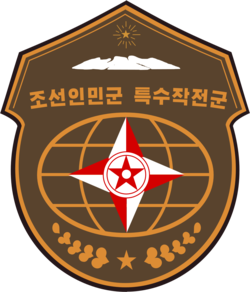|
Korean People's Army Special Operations Forces
The Korean People's Army Special Operations Forces (KPASOF; Korean: 조선인민군 특수작전군; Hanja: 朝鮮人民軍 特殊作戰軍; Chosŏn-inmin'gun teugsujagjeongun) are the special forces of Korean People's Army. It performs military, political, and psychological operations. KPASOF actively tests South Korea; activities were detected in the decades following the Korean War.[4][5] It is commonly estimated that there are 180,000 to 200,000 SOF soldiers.[6] Of this figure only around 60,000 can be considered traditional special forces while the remainder are light infantry.[7] HistoryNorth Korean special operations forces existed by late-1968 when maritime commandos made the unsuccessful Uljin–Samcheok Landings against South Korea.[8] According to Kim Il Sung, the Special Operation Force (then known as the VIII Special Purposes Corps) was "the strongest elite force of the entire Korean People's Army and is the unique vanguard force of the Armed Forces of the Democratic People's Republic of Korea."[9] A new special forces unit wearing modern combat gear, including night-vision goggles and plate carriers, appeared in the Day of the Sun military parade on 15 April 2017.[10] According to North Korean state media, the new elite unit, the Lightning Commandos, was intended to counter the U.S. Navy SEALs and Republic of Korea Navy Special Warfare Flotilla.[11][12] On July 27, 2023, soldiers from the 41st Amphibious Assault Battalion marched during a military parade.[13] Weapons
OrganizationMissionThe missions of the KPA Special Operations Forces are to breach the fixed defense of South Korea, to create a "second front" in the enemy's rear area, and to conduct battlefield and strategic reconnaissance.[25][26] AirborneThe Antonov An-2 transport aircraft is used for infiltration.[9] The aircraft may conduct paradrops or land on highways. Reconnaissance BrigadesSometimes known as "sniper" brigades, they are part of the ground intelligence effort of the KPA.[9] These units also have the ability to perform Direct Action. They train and equip to seize or destroy strategic targets within South Korean territory. Additionally, it is suspected that these units carry out assassination attempts.[9] Light InfantryThe role of the light infantry is the "rapid infiltration and disruption of enemy rear areas through concealed movement". Missions include the seizure forward area lines of communication, and destruction of high-value targets such as nuclear or chemical sites. The light infantry lack amphibious warfare training, but are otherwise similar to the amphibious light infantry. Places that they may be found include the North China Sea.[9] Maritime SOFEstimates reveal that the North Koreans can deliver over 7,000 SOF personnel to each of South Korea's coastlines.[27] Based on the number of ships available to the KPA special forces, they could deliver 5,000 of these soldiers in one lift (approximately 102 amphibious craft).[9] It is expected that these special forces once ashore, will attempt to infiltrate South Korea's rugged terrain to attack the South Koreans in their rear areas just before and during the renewed commencement of hostilities between the two countries.[9] Further, the added capability of a small ship with "stealthy" characteristics enables the commandos the ability to ferry to the South Korean coastline.[28] Like other special forces around the world, close coordination with their sister services provides the needed transportation around the battlefield. For the Maritime SOF, the most commonly used component for modern infiltration has been using the KPA Navy's submarines. The KPA Navy has 24 Romeo class diesel electric submarines.[9] These submarines are used primarily in coastal areas and are an excellent platform to deposit units offshore. Specially outfitted Sang-O class submarines carry a small crew of nineteen and serve the sole purpose of coastal infiltration. Finally, the KPA Navy possesses at least forty-five midget submarines ideally suited to infiltrate two to five man teams into South Korean territory.[29] Such small submarines prove difficult to detect among the rugged coastlines of the Korean Peninsula. References
Bibliography
|
||||||||||||||||||||||||||||||||||||||||||||||||||||||||||
